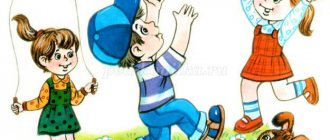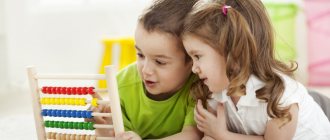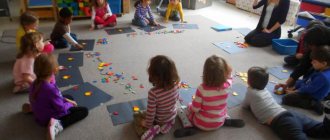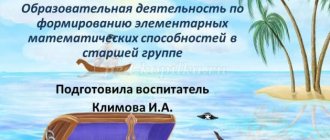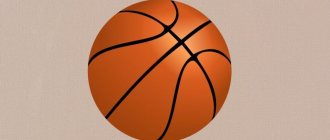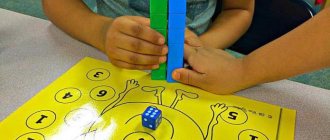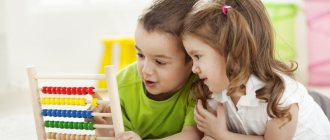MAGAZINE Preschooler.RF
Municipal budgetary preschool educational institution Jalilsky kindergarten No. 1 “Berezka” of a general developmental type, Sarmanovsky municipal district of the Republic of Tatarstan Topic: “FEMP Innovative methods and forms of work” (Message “Current state of mathematical concepts in preschoolers”) Educator of category I, MBDOU No. 1 “Beryozka” Egina Z.V. The practice of preschool educational institutions, the current state of science, technology, and culture places high demands on a person and his education. An important place is given to teaching preschoolers the beginnings of mathematics. This is caused by a number of reasons: the abundance of information received by the child, increased attention to computerization, the desire to make the learning process more intense, the desire of parents, in this regard, to teach the child to recognize numbers, count, and solve problems as early as possible. The main goal is to raise children as people who can think and navigate well in everything that surrounds them. Our task is to lay the foundation for the development of the individual personality in preschool age and develop this individuality under the influence of repeated educational work of the kindergarten and family, since the formation of independent thinking, preparation for creative practical activity is a requirement of the time, a social task that is called upon to be solved, first of all , kindergarten, school, family. Many psychologists and teachers (P.Ya. Galperin, A.N. Leushina, T.V. Taruntaeva, etc.) believe that the formation of mathematical concepts in preschoolers should be based on object-sensory activity, during which it is easier to assimilate the entire volume of knowledge and skills, to consciously master the skills of counting and measurement. This can be achieved if children are taught the elements of mathematics both in involuntary everyday life (in joint activities of children and adults, in communication with each other), and through targeted training in classes on the formation of elementary mathematical concepts. The importance of the practical application of mathematical knowledge in various types of activities was well understood by many progressive teachers in past centuries. When developing issues of developing mathematical concepts in children, they were necessarily concerned about their use in life. So, for example, K.D. Ushinsky wrote: “When initially learning to count... one should also not rush and go further only after mastering the previous one, and having mastered something, never leave it without constant application to the task” (......). At the same time, he emphasized that it is best to apply what has been learned in new conditions, opposite to those in which the child received them. The thoughts of the great Russian teacher have not lost their significance even today. Many researchers of problems of education and development of preschool children (G.S. Kostyuk, N.A. Menchinskaya, M.I. Moro, A.A. Svechnikov, L.I. Skatkin, etc.) note that for the mathematical development of preschool children an integrated approach to solving all problems is required. All this makes the problem of consolidating and applying elementary mathematical concepts in the classroom and in everyday life relevant today. It is necessary that this process be connected with all aspects of the educational work of a child care institution and aimed, first of all, at solving the problems of mental education and mathematical development of preschool children. This can be demonstrated by the example of such types of activities as labor, art, and play, when the task is to count, count, or measure the required number of objects and materials. So, during table setting, the attendants compare the number of cutlery and the number of children (there should be as much cutlery as there are children); during appliqué classes, children are convinced that the number of objects does not depend on their location (five balls remain five balls, regardless of whether they are glued in a pile or in a row, one after another); during games on the site during a walk, they measure the distance between the trees, compare different types of equipment in length, width, height. During classes in productive activities (modelling, drawing, designing), children’s ideas about geometric shapes, the shape, size of objects, their spatial arrangement, and quantity are reinforced. For subject and subject drawings, for ornament and applique, for modeling from clay and plasticine, making complex toys, knowledge about shape, size, quantitative and spatial relationships between parts of an object or between the objects themselves is required, therefore geometric concepts and measuring skills develop and are consolidated in all types of visual activities. Music classes reinforce spatial concepts and counting skills. Together with the music director, children are introduced to the basic properties of musical sound - height (registers), the direction of melodies up and down; with the duration of sounds (longer - shorter); we introduce chords consisting of two, three, five sounds, etc. According to N.A. Vetlugina, children associate these basic properties of musical sounds with spatial, temporal, quantitative concepts: further - closer; higher lower; longer - shorter, etc. In physical education classes, children often encounter quantitative and ordinal counting in constructions. For example, they line up in two or three columns, disperse in pairs to the right and left, and form circles. Circles can be inside another general circle, one moving to the left, the other to the right; marching around the hall (a rectangle, emphasizing the corners at turns), running “in a circle”, “loosely”, “snake”, etc.). When performing various types of exercises, the ability to navigate in space is consolidated: right and left sides, turns in a semicircle, in a circle, etc. Various outdoor games also widely use children’s ability to navigate in time and space, knowledge of measurements using conventional standards or generally accepted measures (counting the distance from one point to another in steps, distances when throwing, running, jump height, etc.) Familiarization classes children with the environment and classes on speech development also give children a lot in terms of mathematical development. For example, children keep a more accurate calendar of nature, using their knowledge of months, weeks, and days. Having realized the fluidity and duration of time, children note how long it is light in different seasons. When caring for plants in a natural corner, in a vegetable garden, flower beds, children measure growth, count the number of buds and flowers, note what happens first, what happens next, and note the sequence of actions. During excursions into nature, to a park or around the city, children’s ability to navigate in space is also strengthened. For example, a walk plan is discussed with the children: “We will cross the road, walk along the sidewalk, then turn right, walk among the houses.” When collecting leaves from the area, we draw the children’s attention to the shape of the petals, their structure, and count their number. When preparing natural materials, children collect and stack dozens of pine cones, acorns, and pebbles. The group count is fixed here. All actions and observations of children will not bring the desired result if they are not reflected in speech. Together with us and independently to each other, the children talk about what geometric shapes the leaves look like, how many large and small cones they have collected, what is more, which plants have short stems and which ones are longer. As research by N.M. Zubareva and R.P. Chudnova shows, when telling a story based on a picture, children must not only describe the plot, but also learn to see the number and placement of characters. That is, it is necessary to pay attention to the pose of the characters and their placement. In a variety of role-playing games, spatial, quantitative and temporal ideas of children are also consolidated. For example, when organizing a role-playing game “Supermarket”, “Cafe” or “Pharmacy”, children count the items that will be sold, put price tags (numbers) on them, prepare banknotes, and manipulate them. When selling bulk goods, cereals (rice, buckwheat, peas), they measure them using conventional measures, this can be a glass, a special spatula, and make their own calculations. In the game “Fashion House” or “Atelier,” when offering fabrics and ribbons for clothing sketches, they measure them by eye or with a conventional measure. In the games “Railway Station”, “Our Street” and others, children themselves set the routes of trains and public transport and number them. It is advisable to teach children to use an hourglass so that children can keep track of the departure time of transport. Children also determine the cost of tickets on different types of transport in different directions. Mathematical competitions are valuable for the development of moral and volitional qualities: persistence in achieving goals, independence, activity, resourcefulness, fairness in assessing the results of the competition, goodwill, courage, objective self-esteem. We hold this type of competition once a quarter. The basis is a variety of entertaining material: riddles, counting rhymes, didactic and outdoor games, exercises with objects and toys, word games, rhyme problems, joke problems, stories, fragments of fairy tales, music, songs. When working with parents on this section, we draw their attention to the fact that the knowledge that children receive in kindergarten must be reinforced at home, in everyday life. For example, while lunch is being prepared, you can invite your child to match the lids to the pots, jars and count what is more: lids or jars, pots or lids, ask where in his opinion there is more water: in the kettle or in the pan, cup or glass? He can verify the correct answer by measuring the water with a liter jar. Find out how many liters of water are in the cup and how many are in the pan. We advise you to pay attention to the development of children’s fine motor skills, work with sticks, string beads on a thread, and launch a top with either your left or right hand. On the way home from kindergarten, pay attention to what changes have happened around you during these days (for example, they removed a bench near the house, built a new house), to changes in nature: more cloudy days, the sun is not visible, leaves on the trees every day become less and less, clarify what day and month it is today. In the store, draw children's attention to the prices of various goods, pay special attention to goods costing up to ten rubles. On the way home, draw the children’s attention to the fact that numbers can be seen everywhere: on buses, numbers of houses, cars, apartments, to the fact that house numbers are not in order (they are even and odd), find out where multi-digit numbers are found (in telephone numbers, house numbers); We recommend purchasing games with numbers for your child, for example, “Fifteen”, “Sixteen”, etc. Examine with your child the different clocks in the house, compare them, discuss how they are similar and how they are different; If there is an old clock in the house, allow the child to take it apart and see what is inside. Pay attention to what time the child wakes up, goes to kindergarten, and goes to bed; How many minutes does it take him to make the bed, get dressed? Ask what can be done in three or five minutes. We remind you that parents at home should pay their children’s attention to what time children’s programs are on TV. Mark significant and memorable dates, birthdays of family members on the calendar, and instruct them to monitor their approach. We advise you to measure lengths at home with children using a ruler (window sill, table, etc.) and draw segments. The practice of using elementary mathematical concepts in the classroom and in everyday life creates sufficient conditions for the strong consolidation of the mathematical knowledge acquired by each child in collective classes. This form of the educational process helps the child acquire solid knowledge, skills and abilities, ensures the development of independence and confidence, creates interest in the quantitative side of reality, and has a positive impact on the further learning of mathematical material at school.| Next > |
Pedagogical Council "USE OF MODERN FORMS OF ORGANIZATION OF WORK ON FEM, TAKEN INTO ACCOUNT OF GEF"
Preschool age is characterized by its own characteristics. The formation of children's knowledge occurs in close connection with their practical actions.
An analysis of the conditions in a preschool institution (educational qualifications of teachers, material and technical conditions: the presence of a mathematics classroom and a computer lab, etc.) and the results of monitoring the development of children (15-18% of preschoolers have a high level of development of elementary mathematical concepts) showed that the time is ripe the need to work on increasing the level of development of elementary mathematical concepts in preschoolers and finding ways to effectively teach in this section.
Kindergarten is the first and very important stage of the general education system. Preschool teachers and scientists currently face a common task - to improve all educational work and improve the preparation of children for school.
An important place should be given to teaching preschoolers the basics of mathematics. This is caused by a number of reasons: the beginning of schooling at the age of six, the abundance of information received by the child, increased attention to computerization, the desire to make the learning process more intensive, and the desire of parents in this regard to teach the child to recognize numbers, count, and solve problems as early as possible. The main goal is being pursued: to raise children as people who can think, navigate well in everything that surrounds them, correctly assess the various situations they encounter in life, and make independent decisions.
Teaching children mathematics in preschool age contributes to the formation and improvement of intellectual abilities: logic of thought, reasoning and action, flexibility of the thought process, ingenuity and ingenuity, and the development of creative thinking. The human brain requires constant training and exercise. As a result of exercise, a person’s mind becomes sharper, and he himself becomes more resourceful and quick-witted.
2. Report “Intellectual games as a means of developing elementary mathematical concepts”
3. Message from work experience “My system of working with parents of students in FEMP”
4. Business game “Mathematics is interesting” (senior teacher)
1. Presentation of a mathematical corner in a group.
2. Master class demonstrating a specific methodological technique for FEMP.
3. “Kaleidoscope of fine arts” drawing up a mathematical puzzle
4. Compiling a puzzle on the topic “Numbers” and “Geometric Shapes”.
Let's consider the techniques used in educational activities on FEMP
